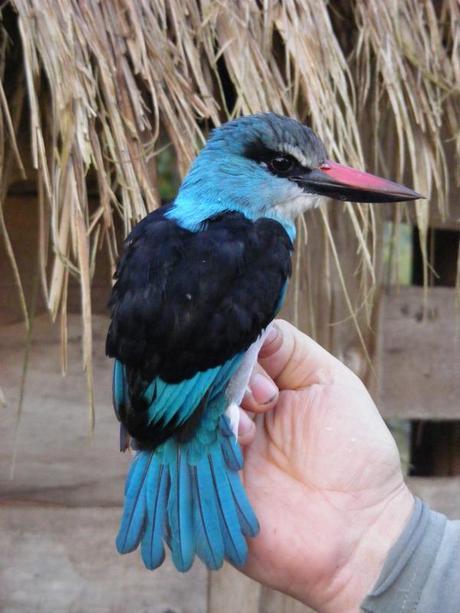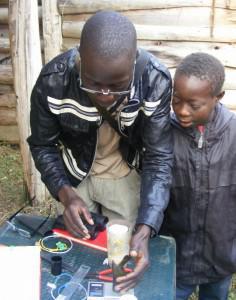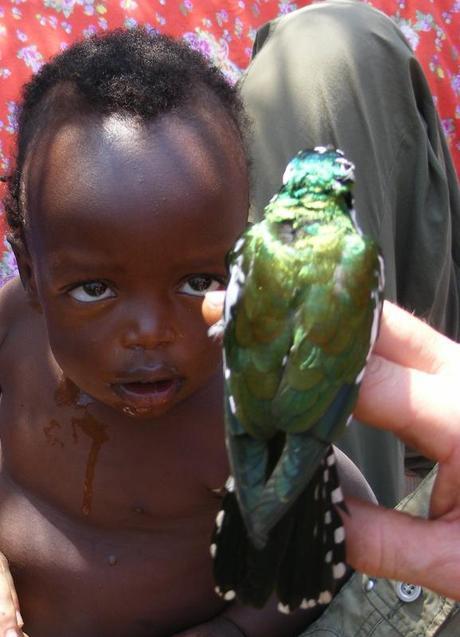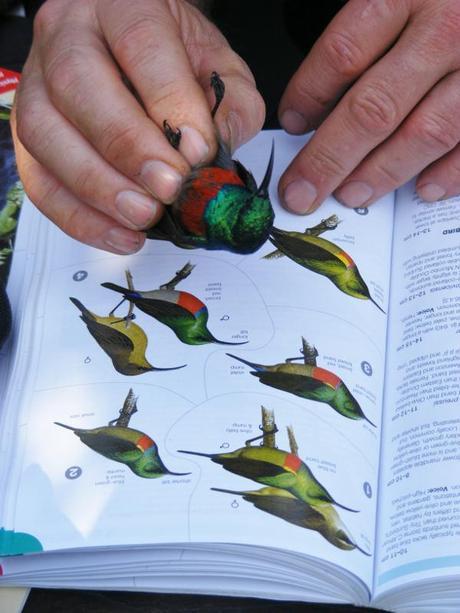According to Roussouw “Kibale Forest harbours the greatest variety and concentration of primates found anywhere in East Africa.” Well, thumbs up to that. Kibale is where the muzungu saw her first wild Chimpanzee, and the apparently ‘elusive’ Red Colobus monkey (although I’m not sure whether the staff at Kibale Forest Camp would agree, hearing them crash through the Forest while they’re serving the guests sundowners every night).
Incredibly rich in animal life, Kibale is a place of many firsts for me. Even after three years in Uganda working mostly in conservation, Mother Nature’s still been holding back on me: my first wild chimp, my first Red Colobus Monkey, my first Green Mamba! But these were all unexpected bonuses – we’d actually travelled to Kibale to ring birds.
The previous day Julia had instructed the boys to hack a pathway through the long grass at the edge of the forest. 4 metre high bamboo poles were hung with a fine nylon ‘mist net’ barely visible at dusk or dawn, gently ensnaring unsuspecting birds. Off with the anoraks and on with the Ipod, there’s as much technology in 21st-century birding as in any walk of life . (Bird calls are stored on the iPod, which is hung strategically close to the Forest to attract the birds). Every few minutes, one of the team would disappear into the Bush to check the net, returning excitedly a few minutes later with their feathered booty in a little cloth bag.

Bird ringing is an exact science!
On our feet since dawn, ringing birds is harder than it looks: concentrating on the welfare of the birds, not leaving them in the net for more than 20 minutes, keeping them cool.
No-one had slept much the night before. We’d been woken at two in the morning by a gargantuan face-off between the chimps in the Forest and three dogs tearing around the compound – all set off by a hungry elephant! It was the chimps that had woken Mandela. He’d then quickly woken Bahati and off they ran to chase the elephants away from the precious pineapple field.
That morning, expert birder and tour guide Malcolm was very excited at rumours of a White Collared Oliveback – “Ooooh, put it back in the bag,” he said, savouring the moment.
Dawn looked nervous when advised she was about to pull ‘a new bird’ out of the bag. It’s a bit like lucky dip really! Or not so lucky in Dawn’s case: she dipped her hand in – and winced in agony as an enormous beak laid into her! The Blue Breasted Kingfisher was one of the weekend’s top finds, with the most experienced ringer ‘getting the tick first.’ If there was envy, no-one let on!

The Blue Breasted Kingfisher was one of the weekend's top finds
Malcolm gave Dawn more warning about the Grosbeak (Thickbilled) Weaver: “Beware Dawn, this one has an 80 pound per square inch peck!” i.e. don’t be fooled by the small beak, it can exert a painfully powerful peck!

Amos watches Nathan identify the latest bird catch
“The secret is to get the kids involved, “ said Richard, encouraging Hope and Amos to hold the birds and help identify them. He was less positive about the Marsh Tchagra: “they bite a lot, like all Shrikes – nasty birds.”

Dillon eyes up a spectacular Diederick's' Cuckoo
Eager to see the birds in the nets (before anyone else!) – I got lost! Twice! Malcolm waved his finger at me sternly as Nathan and I rejoined the group back in the shade by the house. “Don’t spend so much time by the nets,” he said. I felt embarrassed.
Highlights of the two days’ ringing included a pair of exquisite Greyheaded Negrofinches, Greenbacked Twinspots, a Little Greenbul (I was relieved to hear the experts struggle to identify birds too!) and a Brownchested Alethe (a type of Forest Thrush that can only be caught with an iPod and a mist net); a Green Hylia (a type of warbler), an Olive-bellied Sunbird and a tiny White Ringed Prinia.

Identifying a Sunbird - not always easy, even with the bird guide!
It was a real treat for an amateur birder like me to see such wonderful birdlife come out of the forest. Everyone pointed out birds flying overhead and in trees around us: an emerald green Diederick’s Cuckoo, Lesser Striped Swallows, African Grey parrots, a Superb Sunbird; a Black Crowned Tchagra (a shrike) in the long grass.
The Roussouw guide says “watch for flocks of rare and localised White Naped Pigeons in-flight overhead or sunning themselves in treetops in the early morning” and lo and behold, they were in front of us.
Fascinating and fun too, the two days’ information collected is baseline data for a study of the biodiversity of the forest edge. The data’s being shared with Nature Uganda, one of the partners in a new East African bird ringing scheme.
Julia has plans for the area too – but you’ll have to sign up to my newsletter to find out what she’s hatching!

TICK! Here's the full list of the birds I saw in Kibale Forest (R = ringed)
- African Blue Flycatcher
- African Grey Parrots
- African Yellow Whiteye (R)
- Black Crowned Tchagra
- Blue Breasted Kingfisher (R)
- Bronze Mannikin
- Bronze Sunbird
- Brown-chested Alethe (R)
- Brown-throated Wattle-eye
- Diederick’s Cuckoo
- Dusky Blue Flycatcher
- Green Crombec (R)
- Green Hylia (R)
- Green Twinspot (R)
- Greenbacked Twinspots (R)
- Grey-backed Camaroptera (R)
- Greyheaded Negrofinch (R)
- Grosbeak (Thickbilled) Weaver (R)
- Klaas’s Cuckoo (R)
- Lesser Striped Swallow
- Little Greenbul (R)
- Marsh Tchagra (R)
- Northern Double Collared Sunbird
- Olive Bellied Sunbird (R)
- Pygmy Kingfisher (R)
- Ross’s Turaco
- Slender-billed Weaver (R)
- Snowyheaded Robin chat (R)
- Superb Sunbird
- Vieillot’s Black Weaver
- White Naped Pigeon
- White Collared Oliveback (R)
- White Naped Pigeon
- White Chinned Prinia (R)
- White-headed Saw-wing
- Yellow Rumped Tinkerbird (R)
- Yellow Whiskered Greenbul (R)

